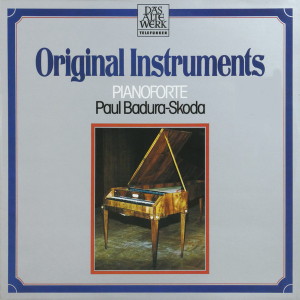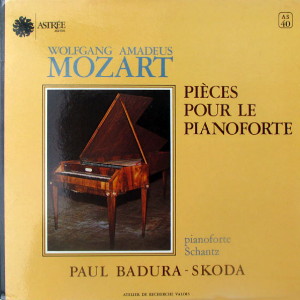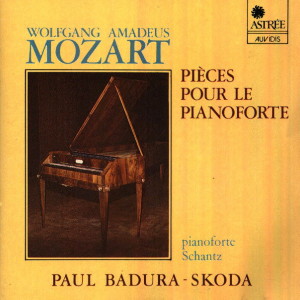 |
1 LP -
Telefunken 6.42425 AP (p) 1978
|
 |
| 1 LP -
Astrée AS 40 (p) 1979 |
 |
| 1 CD -
Astrée E 7710 (c) 1986 |
|
| ORIGINALINSTRUMENTE - Pianoforte |
|
|
|
|
|
|
|
| Wolfgang Amadeus
Mozart (1756-1791) |
Praeludium
und Fuge C-dur, KV 394 (383a) |
|
8' 53" |
A1 |
|
Kleiner
Trauermarsch, KV 453a (Marche
funèbre del Sig. Maestro
Contrapunto) |
|
1' 38" |
A2 |
|
Adagio
h-moll, KV 540 |
|
9' 14" |
A3 |
|
Menuett
D-dur, KV 355 (576b) - Trio G-dur
(Komponist unbekannt, vielleicht
Mozart, augefunden von Badura-Skoda) |
|
4' 53" |
A4 |
|
Kleine
Gigue G-dur, KV 574 |
|
1' 39" |
A5 |
|
Fantasie
d-moll (Fragment), KV 397 (385g) |
|
5' 27" |
B1 |
|
Rondo
a-moll, KV 511 |
|
9' 29" |
B2 |
|
Zwölf
Variationen über "Ah, vous
dirai-je, Maman", KV 265 (300e) |
|
12' 09" |
B3 |
|
|
|
|
|
| Paul BADURA-SKODA,
Pianoforte (von Johann Schantz,
um 1790; Sammlung: Paul
Badura-Skoda) |
|
|
|
|
|
Luogo
e data di registrazione |
|
Haus
der Begegnung, Vienna (Austria) -
marzo 1979
|
|
|
Registrazione:
live / studio |
|
studio |
|
|
Production |
|
Michel
Bernstein
|
|
|
Recording
Supervision
|
|
Dr.
Thomas Gallia, Pere Casulleras
|
|
|
Edizione LP |
|
TELEFUNKEN
- 6.42425 AP - (1 LP - durata 54'
20") - (p) 1978 - Analogico |
|
|
Originale LP
|
|
Astrée
- AS 40 - (1 LP - durata 54' 20")
- (p) 1979 - Analogico |
|
|
Prima Edizione CD |
|
Astrée
- E 7710 - (1 CD - durata 57' 20")
- (c) 1986 - AAD
|
|
|
Note |
|
Produced
by Astrée
|
|
|
|
|
An
instrument upon
which, by means of
varying touch, one
could play piano
and forte as well
as dynamicinterim
stages,was at the
time of its
development the
expression of
stylistic change.
In 1709 the
Florence
instrument maker
Cristofori for the
tirst time
constructed a
hammer mechanism;
independently of
him Gottlieb
Schröter of
Dresden invented
another form in
1717, while inl
731 the Saxonian
organbuilder
Gottfried
Silbermann built
two hammer-action
instruments or
pianofortes. With
each of these
instruments the
tone was produced
by a hammer
beating the string
instead of
transverse
plucking ofthe
string with a crow
quill plectrum.
But it was not
until after the
middle of the 18th
century that the
new instrument
began to assert
itself, not least
of all because of
new dynamic ideals
which were no
longer those of
the baroque. At
the same time the
period, which more
or less covered
the lifetimes of
Mozart and
Beethoven, was
marked by
far-reaching
changes in the
history of piano
construction to a
degree not
observed with any
other instrument
within such a
brief space of
time.
The decisive
technical point -
in addition to
especially
fashionable
accessories such
as various extra
tone colour
registers - was
the attachment of
the hammer and
thus its mode of
operation and
employment by way
of the keys. Two
basic lines with
intrinsically
divergent
variations took
shape: the
fastening of all
hammer shanks to
one axle in the
hammer rest rail,
and the individual
hanging of each
hammer shank in
turn to a capsule
fitted to a rest
rail. In principle
the first
construction
followed
Cristofori’s idea
and was
considerably
improved in London
by Broadwood; one
refers therefore
also to the
English or the
thrust mechanism
(according to the
action). It has
the advantage of
giving greater
volume, but calls
for a heavier
touch. The other
action - referred
to as German,
Viennese or impact
mechanism - is
easier to use and
the tone is thus
more capable of
modulation, but
the hammer has
less power in the
touch and
therefore produces
a smaller volume.
In 1817 Beethoven
received as a
present from
Broadwood an
instrument with an
English mechanism,
but he never
played it, and his
Hammerklavier
Sonata was not
intended for this
instrument as is
often claimed: the
instrument does
not have the tonal
volume required in
the work. Haydn,
Mozart and
Beethoven had
adapted themselves
to the Viennese
mechanism.
The most important
pioneer of such
instruments was
the piano and
organbuilder
Johann Andreas
Stein (1728-1792)
whose last
domicile was
Augsburg. His
daughter Nannette
moved the business
to Vienna in 1794
and married into
the piano-makers’
family of
Streicher.
Beethoven was on
friendly terms
with the family
all his life.
Through Stein he
also became
acquainted with
the brothers
Wenzel and Johann
Schanz (also spelt
Schantz) who
hailed from
Bohemia. Wenzel
settled down in
Vienna in 1780 and
following his
death (around
1790) Johann (who
died in 1828)
carried on the
business. The
Schanz brothers
were, besides
Anton Walter, the
most important
piano makers in
Vienna until they
faced considerable
competition from
Stein-Streicher.
When providing
advice to Marianne
von Genzinger,
Haydn especially
praised the Schanz
instruments in a
letter dated 4th
July, 1790:
“...for this
reason I would
like to suggest
that Your Highness
try one by H.
Schanz. His forte
pianos have a
quite particular
lightness and a
pleasant action.
It is highly
necessary for Your
Highness to have a
good forte piano,
and my Sonatas
will be all the
better for this”.
Gerhard
Schuhmacher
(English
translation by
Frederick A.
Bishop)
|
|
|

